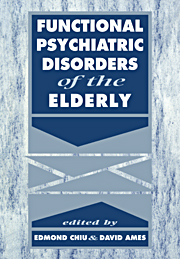Book contents
- Frontmatter
- Contents
- List of contributors
- Preface
- Introduction – A personal note
- Acknowledgement
- Part 1 Classification
- Part 2 General epidemiology
- Part 3 Neuroses
- Part 4 Affective disorders
- 7 The epidemiology of affective disorders in old age
- 8 The outcome of depressive illness in old age
- 9 Pseudodementia in geriatric depression
- 10 Depression in nursing and residential homes
- 11 Depression in primary care settings
- 12 Treatment of depression in the elderly
- 13 Mania in late life: conceptual and clinical issues
- 14 Suicide in the elderly
- Part 5 Psychosexual disorders
- Part 6 Substance use and abuse
- Part 7 Schizophrenia and related psychoses
- Part 8 Psychological, biological and medical issues
- Part 9 Treatment methods
- Part 10 Conclusion
- Index
9 - Pseudodementia in geriatric depression
from Part 4 - Affective disorders
Published online by Cambridge University Press: 13 November 2009
- Frontmatter
- Contents
- List of contributors
- Preface
- Introduction – A personal note
- Acknowledgement
- Part 1 Classification
- Part 2 General epidemiology
- Part 3 Neuroses
- Part 4 Affective disorders
- 7 The epidemiology of affective disorders in old age
- 8 The outcome of depressive illness in old age
- 9 Pseudodementia in geriatric depression
- 10 Depression in nursing and residential homes
- 11 Depression in primary care settings
- 12 Treatment of depression in the elderly
- 13 Mania in late life: conceptual and clinical issues
- 14 Suicide in the elderly
- Part 5 Psychosexual disorders
- Part 6 Substance use and abuse
- Part 7 Schizophrenia and related psychoses
- Part 8 Psychological, biological and medical issues
- Part 9 Treatment methods
- Part 10 Conclusion
- Index
Summary
Introduction
The term pseudodementia has been used to describe a dementia syndrome that develops in the context of a psychiatric disorder and subsides when the psychiatric symptomatology is ameliorated. The term was first used by Madden, Luban & Kaplan (1952) to describe patients with psychiatric disorders accompanied by defects in recent memory, calculation, and judgment that improved upon alleviation of their psychiatric condition. Pseudodementia was observed in 10% of patients in the series of Madden et al. (1952). Since then, the term pseudodementia has been associated with a reversible dementia syndrome resulting from a psychiatric illness. The concept of pseudodementia generated further interest when Kiloh (1961) reported ten cases of pseudodementia associated with hysteria, malingering, Ganser syndrome, paraphrenia, depression and mixed mood disorders. Kiloh emphasized that failure to identify cases with reversible dementia due to psychiatric disorders may promote therapeutic nihilism and abandonment of treatable cases or lead to unnecessarily invasive diagnostic studies.
The term pseudodementia has been questioned by authors who emphasized the role of brain dysfunction in such cases. Folstein & McHugh (1978) argued that depression can give rise to a dementia syndrome which, although reversible, has a biological basis and should not be viewed as a false dementia. Conceptualization of pseudodementia as a nondementia, may hinder the search for underlying biologic mechanisms. Given the high frequency of pseudodementia in the elderly, Folstein & McHugh (1978) hypothesized that pseudodementia develops when the neurobiological disturbances of affective disorders are superimposed on a compromised aging brain.
- Type
- Chapter
- Information
- Functional Psychiatric Disorders of the Elderly , pp. 126 - 141Publisher: Cambridge University PressPrint publication year: 1994
- 3
- Cited by

